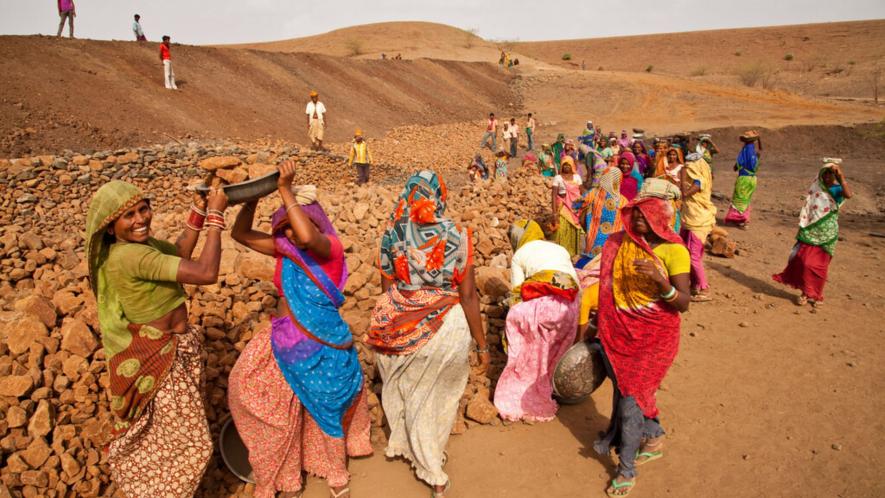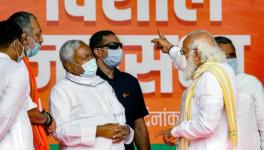From Guarantee to Denial: How MGNREGA is Being Systematically Weakened

Representational Image. Image Courtesy: Flickr
Recent media reports indicate that the government has imposed restrictions on spending under the Mahatma Gandhi National Rural Employment Guarantee Act (MGNREGA). According to a report published in The Indian Express on June 10, the government has capped expenditure under MGNREGA to 60% of the annual allocation for the first half of the financial year 2025–26. This decision is a blatant assault of the very idea under which MGNREGA was envisioned.
Undermining MGNREGA’s Foundational Idea
MGNREGA is a demand-driven programme that legally guarantees employment to any rural household willing to do unskilled manual work. As per the law, work must be provided whenever a worker demands it, until the 100-day limit per household is reached. There should be no restriction on this process. The right to demand work at any point during the financial year is central to the Act. Any limitation on this is a violation of workers’ legal rights.
Due to its demand-driven nature, MGNREGA was originally exempt from the expenditure control framework of the Ministry of Finance. The Monthly/Quarterly Expenditure Plan (MEP/QEP) was introduced in 2017 to regulate the so-called cash flow and avoid unnecessary borrowing. Until now, MGNREGA, under the Ministry of Rural Development, was exempt from this scheme because the ministry argued that setting fixed expenditure limits was impractical for a demand-based programme. However, the Finance Ministry has now instructed that starting FY 2025–26, MGNREGA too will be brought under the MEP/QEP framework.
A Policy Assault on the Right to Employment
This move is not surprising considering the track record of the Narendra Modi government, which has continuously and systematically weakened MGNREGA. It does not just weaken the scheme but also attacks the right to work itself. From slashing budgets to introducing complex and often exclusionary technological interventions in the name of curbing corruption, the government has consistently undermined the core principle of MGNREGA. These steps not only ignore the scheme’s well-documented utility but also expose the government’s apathy toward the growing rural economic crisis and unemployment.
If the new restrictions are implemented, only ₹51,600 crore out of the ₹86,000 crore allocated for FY 2025–26 will be available for use by the end of September. A significant chunk, Rs. 21,000 crore, has already gone into clearing last year’s pending dues. This decision will severely impact job creation under the scheme and dissuade workers from demanding employment, despite ground-level demand.
Inadequate Budget, Root of Most Problems
The consistent underfunding and delayed allocation of funds to states lie at the heart of MGNREGA’s weakening. Despite frequent tall periodic claims by the Union Finance Minister that there is no shortage of funds to meet the demand of work and that employment demands are met without restriction, the ground reality is vastly different.
The lack of funds indirectly results in the capping of work demand, with workers being dissuaded through various mechanisms. A 2024 Parliamentary Committee report flagged this as a major flaw, pointing out that setting lower budgets at the start of the year adversely affects key aspects of implementation. The committee recommended that allocations should be based on expenditure trends from previous years to ensure smooth functioning.
Many economists, including the People’s Action for Employment Guarantee, have recommended an annual allocation of at least ₹2.64 lakh crore for MGNREGA. The World Bank, too, has suggested that 1.7% of the country’s GDP (gross domestic product) should be earmarked for the programme. However, for FY 2024–25, the allocation is a mere 0.26% of GDP. Even for the upcoming FY 2025–26, the government has maintained the same inadequate budget of ₹86,000 crore. In the context of widespread rural distress, this is grossly insufficient and clearly shows that livelihood security for rural poor is not a government priority.
A Parliamentary Committee, in its eighth report presented on May 22, 2025, highlighted that wage delays remain a serious issue under MGNREGA, affecting millions who rely on it for livelihood. Despite repeated recommendations from the committee, the government has ignored these suggestions, though it promptly implements any proposal that could further weaken the scheme.
Anomalies in Wage Calculation
The committee has also recommended raising MGNREGA wages to at least Rs. 400 per day, stating that current rates were insufficient to cover basic daily expenses. In a report submitted to Parliament in March this year, the committee called for revising wage rates based on the real impact of inflation on rural households.
Currently, MGNREGA wages are calculated based on the Consumer Price Index for Agricultural Labourers (CPI-AL), using 2009 as the base year. The committee strongly criticised this outdated method, terming it irrelevant and incapable of reflecting current inflation and living costs.
The Mahendra Dev Committee had earlier suggested updating the base year to 2014. The Anoop Satpathy Committee also recommended a minimum daily wage of Rs. 375. However, the Central government has ignored all such recommendations. This year, wage rates were increased by a meagre 2% to 7%. Low wages deter workers from participating in the scheme, weakening the very objective of providing rural employment.
Increasing MGNREGA wages is not just an economic necessity but also a matter of social justice and rural empowerment. Inadequate wages limit the programme’s effectiveness and perpetuate poverty, exploitation, and backwardness. If wages are aligned with inflation, minimum wage standards, and actual cost of living, MGNREGA can become a powerful tool for rural transformation. It will strengthen income security, uphold workers’ rights, and enhance their dignity.
The Need to Increase the Number of Workdays
The parliamentary committee made another important recommendation: increase the number of guaranteed workdays from 100 to 150 per household. This has been a long-standing demand. However, in practice, even the 100-day promise is not being fulfilled. In FY 2024–25, the average workdays per household stood at only 50.18. Only 7% of registered households received the full 100 days of employment.
As of now, there are 15.33 crore job cards under MGNREGA, covering 26.39 crore registered workers. Among these, 8.41 crore job cards are active, and 11.98 crore workers are currently working. However, in FY 2024–25, total person-days fell by 7.1%, from 288.83 crore in FY 2023–24 to just 268.44 crore.
MGNREGA Crisis in West Bengal
In West Bengal, 2.56 crore registered workers with job cards have been denied employment under MGNREGA in the past three years, despite being eligible for unskilled labour. Their legal right to employment under MGNREGA has been suspended due to allegations of corruption. It is true that MGNREGA implementation across several states, especially West Bengal, has been plagued by serious corruption involving contractors, local leaders (mostly affiliated with the ruling Trinamool Congress), and various levels of bureaucracy. However, penalising innocent workers is deeply unjust.
Neither the Central nor the state government has shown the political will to tackle corruption. Instead of addressing the issue, the Bharatiya Janata Party-led Central government uses corruption allegations to attack the TMC for political gains. Meanwhile, the TMC portrays itself as a victim to garner sympathy. In this tug-of-war, the worst affected are the labourers—innocent, hardworking people deprived of their legal rights.
Citing Section 27 of the MGNREGA Act, 2005, the Centre has stopped financial aid to West Bengal. This section empowers the government to withhold funds in case of rule violations in implementation. Finally, the Calcutta High Court has had to direct the Central and the state government to prospectively implement the MGNREGA scheme in the state of West Bengal from August 1, 2025.
Scams in Gujarat & BJP’s Double Standards
Neoliberal policies can be blamed for big corruption in the country. For, it is through these policies that resources that belong to the people are being captured by a few big capitalists. Other than supporting these neoliberal policies, recent developments have exposed the hollowness of the BJP’s anti-corruption narrative.
In Gujarat—projected as the BJP’s "model state"—several huge MGNREGA scams have come to light. In one case, Balwant Khabad, son of Gujarat's Panchayat and Agriculture Minister Bachu Khabad, was arrested in Dahod district for allegedly defrauding MGNREGA of over ₹70 crore. Investigations revealed that fake infrastructure projects—roads, dams, and other public works—existed only on paper. Funds meant for employment of tribal communities under MGNREGA were siphoned off using forged documents and sent to agencies linked to the minister’s sons.
To gauge the sincerity of governments in fighting grassroots corruption, one must examine the status of social audits, a powerful tool for community monitoring and transparency. Despite their importance, parties and governments that claim to fight corruption often avoid social audits. MGNREGA social audit teams are regularly threatened, harassed, and pressured to submit false reports. Over the past decade, the BJP government’s track record on implementing MGNREGA has been deeply disappointing, reflecting consistent attacks on the scheme’s core principles.
The persistent weakening of MGNREGA is not just a bureaucratic failure; it is a systematic assault on the hard-won right to employment for India’s rural working class. Without adequate funding, timely wage payments, fair wage rates, increased workdays, and genuine accountability mechanisms like social audits, the world’s largest employment guarantee scheme risks becoming a mere shadow of what it was envisioned to be.
The writer is Joint Secretary, All India Agriculture Workers Union. The views are personal.
Get the latest reports & analysis with people's perspective on Protests, movements & deep analytical videos, discussions of the current affairs in your Telegram app. Subscribe to NewsClick's Telegram channel & get Real-Time updates on stories, as they get published on our website.
























